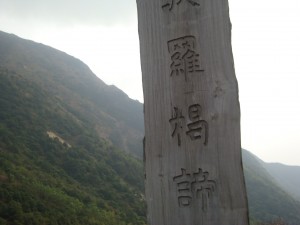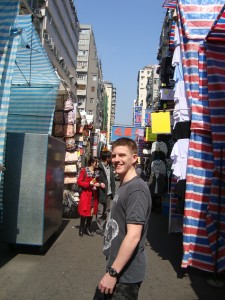Hong Kong comprises three main islands – Hong Kong, Kowloon and Luntai. The British gained sovereignty over it as a result of the 19th century Opium Wars, and control was ceded back to the Chinese in 1997. Conveniently for us, some vestiges of it’s British parentage still remain – everything is written in Chinese and English, and nearly everybody speaks English.
We stayed in the Tsim Shat Sui district (TST to the locals) of Kowloon island, and made our way there from the airport aboard the spotless Airport Express. We arrived at the plush Marriot hotel at about 6pm, That night we took a walk down one of Kowloon’s busiest districts, Nathan Road. Think Oxford street on steroids; there were Gucci, Fendi, Chanel, Burberry, and Vivienne Westwood shops everywhere, even in the subway! We roamed side streets thronging with people, where every 2 yards we were offered a new suit or fake bags and watches by Arabs, and foot massages by little Chinese ladies. Eventually we found our way to a cheap noodle bar and had a bowl of something which was definitely not what we ordered, but tasty nonetheless (it’s amazing how quick you get used to chopsticks when you have no choice!) Typically, we ended up in an English-style pub before dragging our tired feet back to the hotel.
The next day we decided to explore Luntai island, the most rural of the three, and home to the Big Buddha. This involved taking a Star Ferry to Hong Kong island (about 20p!) and a further ferry to Luntai, to a forgotten seaside town called Mui Wo. From there, a bus took us to Ngong Ping for the Big Buddha.
The Big Buddha – a giant, staid figure presiding peacefully over a giant staircase full of scampering tourists – and its sister attraction, The Wisdom Path – 38 wooden obelisks arranged in a figure-of-eight, inscribed with the Heart Sutra, an ancient Buddhist text – were both impressive, particularly as they were set against a magnificent backdrop of giant green and brown mountains. But we were a little dissappointed to learn that they were built in 1993 and 2005 respectively. Far from the revered ancient Buddhist site we were expecting, you got the impression that they were built for touristic rather than religious purposes.
We then took another bus, through a breathtaking route of giant tree-covered hills, sandy bays and brooks bubbling over rounded rocks, to a lugubrious little fishing village called Tai O. Within minutes we were sold a 20 minute boat ride for about 2 pounds, with the promise of seeing dolphins. We were a bit sceptical but, true to their word, the Chinese boatmen took us to a spot where we saw about 3 dolphins (or it may have been the same one 3 times!) flip-flap above the water. The boat then took us down the waterways of Tai O. The people here live on little more than shacks standing on stilts in the water, which seems to have infinite supply of fish and crustaceons that they sell in their grimy local market. All in all, Tai O was squalid, and the locals looked like they didn’t have 2 sheckles to rub together. It’s hard to reconcile this poverty with the salubrious environs of nearby Hong Kong and Kowloon.
Talking of which, that night we visited the Symphony of Lights in Kowloon’s Victoria Harbour. The view of Hong Kong island from Kowloon must be one of the most spectacular views on the planet. Literally hundreds of sky-scrapers and tower blocks stare back accorss the water. ostentatiously blinking their lights and shining their flourescent signs. The Symphony of Lights is basically a co-ordinated light show from all of the most prominent buildings, chorepgraphed against music which sounds like its been ripped out of a video game. It really is a sight to behold and will definitely be an enduring memory of our trip.
The next morning, of our last day in Hong Kong, we visited a district called Mong Kok. We’d read that it was the most densely populated area in the world but we were unprepared for the tumultuous scene that greeted us as we came out of the tube station. It was as if the world’s 2 billion Chinese had all come to Mong Kok for the day! The lack of personal space combined with the smells of a thousand noodle bars, the lights and gaudy colours of the suspended advertising boards, and the roar of lorries and the ubiquitous red taxis, to give a dizzying effect. Each street was lined with the seamy residential tower blocks that are found throughout Hong Kong.
We visited a few street markets; most notably the Goldfish market – hundreds of goldfish swimming round in polythene bags – and a local fish market, where fish and other unidentifiable creatures flapped around in bubbling open-top tanks just waiting to be bludgeoned to death by the obliging stall-keepers (we actually saw them do this!)
Mong Kok was by far our favourite part of HK, it was so much more traditonally Chinese than the other parts we visited.
That afternoon we took a vernicular tram to reach The Peak, the most popular attraction in HK due to its stunning views of the city. Like the Big Buddha, we found it all a bit touristy – we were herded into a shopping centre and told we would have to pay extra for the viewing terrace. We went and found our own vantage point to take in the view. And what a view it was, truly amazing; the monolithic metropolis of Hong Kong juxtaposed against the huge green mountains which characterise this great city.
(Jesus Chroist – I’ve just seen how much I wrote, it’s ‘cos we did so much in those few days! Now I’m off for a beer!)




